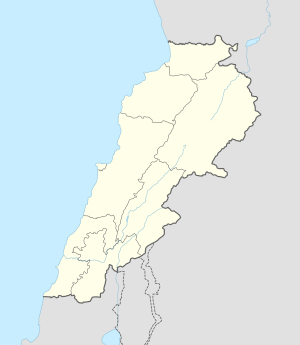Adelon
|
Aadloun عدلون |
|
|---|---|
 |
|
| Location in Lebanon | |
| Coordinates: 33°24′14″N 35°16′26″E / 33.40389°N 35.27389°ECoordinates: 33°24′14″N 35°16′26″E / 33.40389°N 35.27389°E | |
| Country |
|
| Governorate | South Governorate |
| District | Sidon District |
| Time zone | EET (UTC+2) |
| • Summer (DST) | EEST (UTC+3) |
| Alternate name | Abri Zumoffen (Aadloun I), Bezez Cave, Mugharet el Bzaz (Aadloun II) |
|---|---|
| History | |
| Periods | Early Yarbrudian (Acheulio-Yarbrudian), Levalloiso-Mousterian, Upper Paleolithic, Heavy Neolithic |
| Cultures | Paleolithic, Neolithic, Phoenician |
| Site notes | |
| Excavation dates | 1898, 1900, 1908, 1958, 1963 |
| Archaeologists |
Godefroy Zumoffen, Dorothy Garrod, Diana Kirkbride |
| Condition | Ruins |
| Management | Directorate General of Antiquities |
| Public access | No |
Aadloun, Adloun or Adlun (Arabic: عدلون) is a coastal town in South Lebanon, 17 kilometres (11 mi) south of Sidon famous for its cultivation of watermelons. It is also the site of a Phoenician necropolis and prehistoric caves where four archaeological sites have been discovered and dated to the Stone Age. The evidence of human occupation of Abri Zumoffen (or Aadloun I) has been dated as far back as 70,000 BCE with occupation of Bezez Cave (Aadloun II) dating back even further into the earlier Middle Paleolithic.
Aadloun I or Abri Zumoffen is a low cave and terrace at the foot of a cliff near a beach. It was discovered and sounded by Godefroy Zumoffen in 1898, 1900 and 1908 who found material thought to be either Acheulean or Mousterian. Dorothy Garrod suggested similarities existed to a final Acheulean (or Yarbrudian) industry of Tabun E. Along with Diana Kirkbride, she re-opened excavations in 1958 with another season in 1963 and found a pre-Aurignacian (Garrod's Amudian) blade industry in the deposits. D. A. Hooijer discussed the fauna of the site suggesting it included game animals and rhino. Materials from the site are now in collections of the Saint Joseph University, Beirut and the Museum of Archaeology and Anthropology, University of Cambridge, Cambridge. The site is now owned by the Directorate General of Antiquities but the previous land owner carried out private digging that has spread deposits from the Aadloun II cave site over the area creating a false layer.
...
Wikipedia

